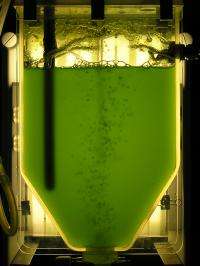Climate change seems unfavourable for toxic blue algae

The earth is warming up due to rising carbon dioxide concentrations in the atmosphere. NWO-funded researchers have discovered that the increase in carbon dioxide can reduce the nuisance caused by toxic blue algae, a bacterium commonly found in swimming water throughout the Netherlands in the summer. At higher temperatures the blue algae grow better, but due to rising carbon dioxide concentrations the non-toxic variant of blue algae ousts its harmful little brother.
Researchers from the University of Amsterdam and the Netherlands Institute for Ecology have both good and bad news. The bad news is that at high temperatures blue algae do indeed grow better than other algal species. However, the good news is that the rising carbon dioxide concentrations mean that the toxic blue algae are being ousted by non-toxic blue algae. This research will be published in September in the ISME Journal and will also be discussed in the News & Views section of the Journal Nature Climate Change.
Toxic blue algae can cause gastrointestinal complaints, nausea, diarrhoea, headache, skin irritation and irritated eyes, and at higher concentrations can also cause severe damage to the liver and nervous system.
Temperature rise
During the summer of 2003, a field experiment was carried out in the Nieuwe Meer lake (Amsterdam) to control blue algae. The experiment failed: the blue algae were found to grow better than expected. This might have been due to the extreme heat wave of that summer.
To gain an understanding of this process, the researchers developed a model in which algal growth was linked to the climate. The model revealed that at high temperatures blue algae grow faster than other algal species. Moreover, high temperatures make the water more stable as a result of which it mixes less well. The algae have small gas vesicles, and in stable water they use these to float the surface where there is a lot of light. This enables them to grow even better still.
The predictive model and the explosive blue algae growth in 2003 matched exactly. So initially, the researchers thought that future climate change would lead to even more nuisance from blue algae, especially during warm weather. However, other factors also play a role.
Rising carbon dioxide concentrations
Carbon dioxide concentrations in the atmosphere are rising rapidly as a consequence of human activities. Blue algae need carbon dioxide to photosynthesise and can therefore benefit from higher carbon dioxide concentrations. However, do all blue algae benefit equally from the increase in carbon dioxide? To answer this question the researchers developed a model that predicted the competition between toxic and non-toxic blue algae.
The model revealed that the toxic substance facilitated the uptake of carbon dioxide for photosynthesis. Toxic blue algae therefore grow well at low carbon dioxide concentrations, whereas non-toxic algae benefit from high carbon dioxide concentrations. This was confirmed in competition experiments in the laboratory with various toxic and non-toxic blue algae.
The results would therefore appear to be a cloud with a silver lining: although global warming stimulates the growth of the blue algae, these algae will become less toxic due to rising carbon dioxide concentrations. Further research is needed to demonstrate if these laboratory tests can be confirmed in the field situation.














